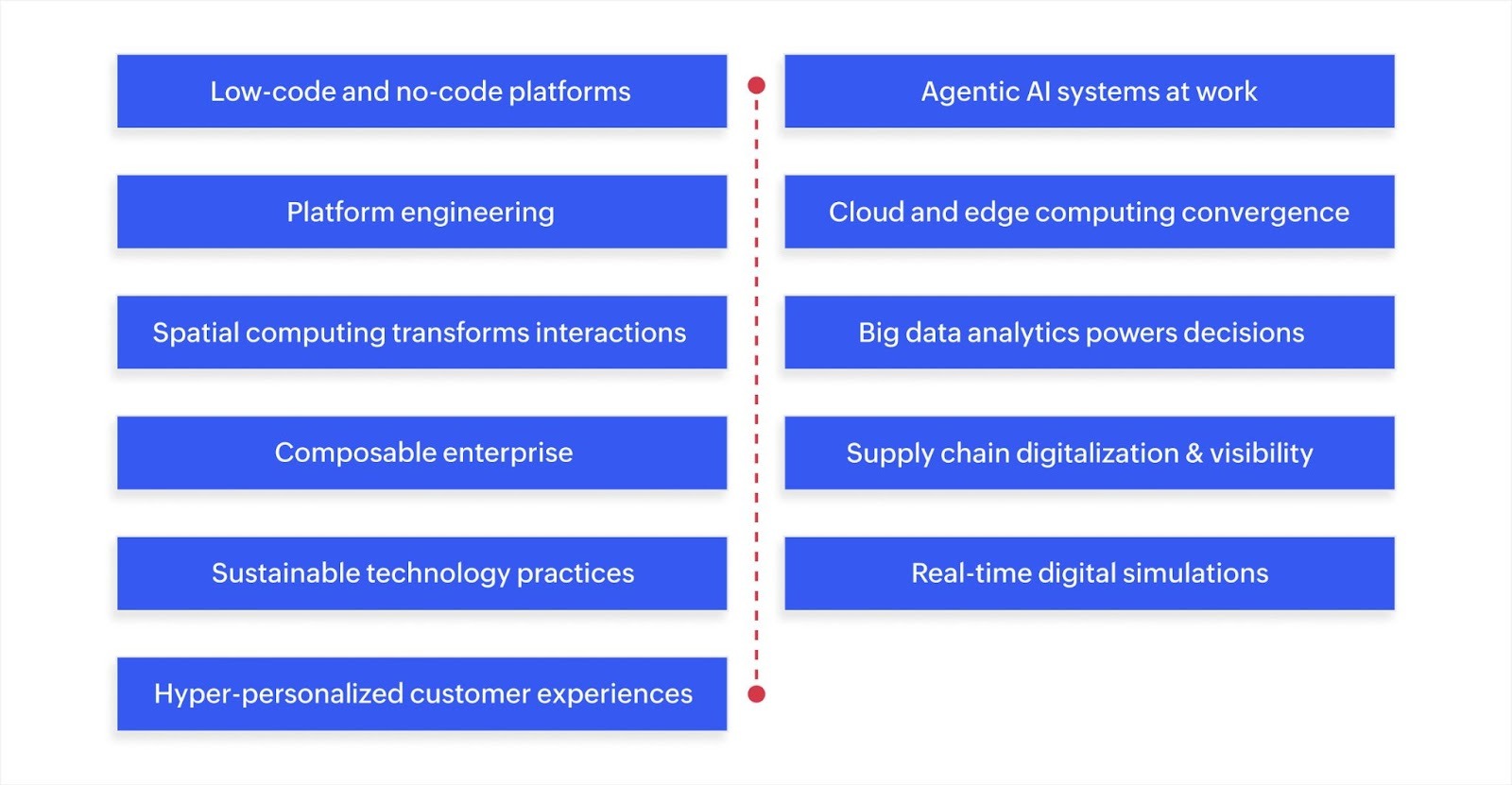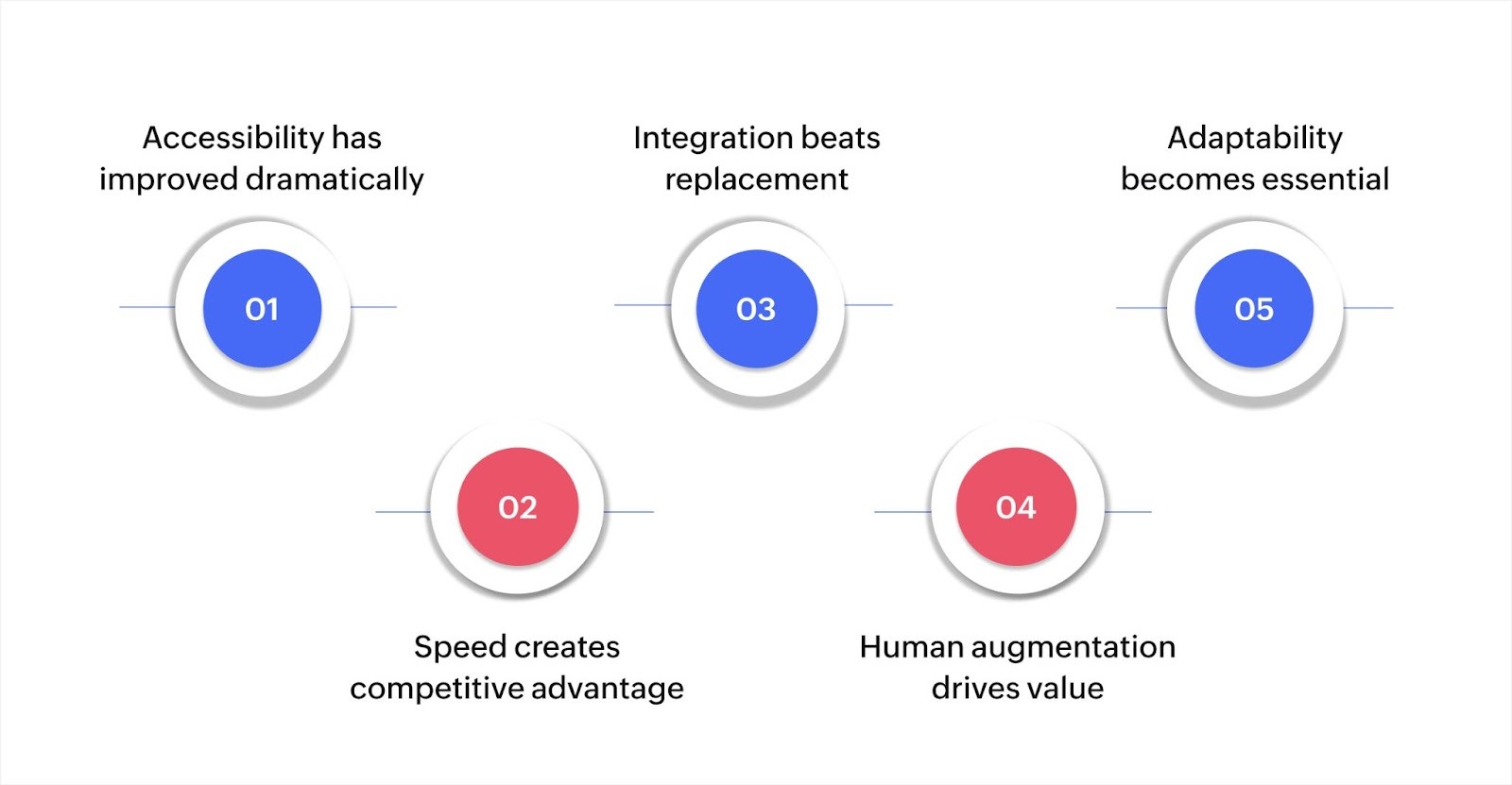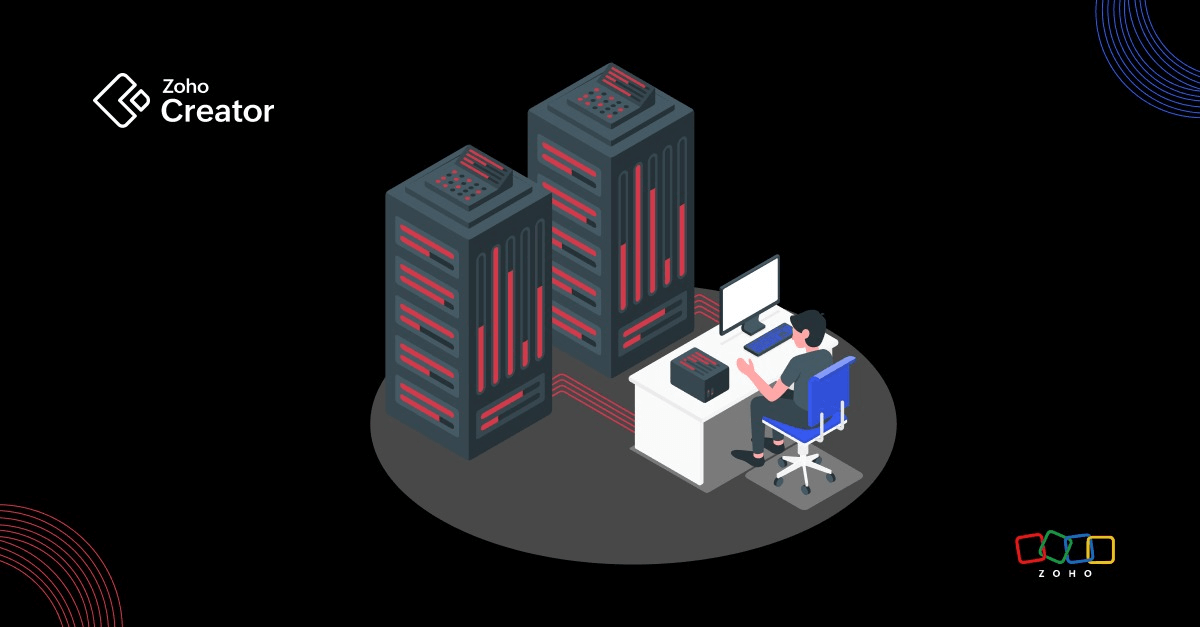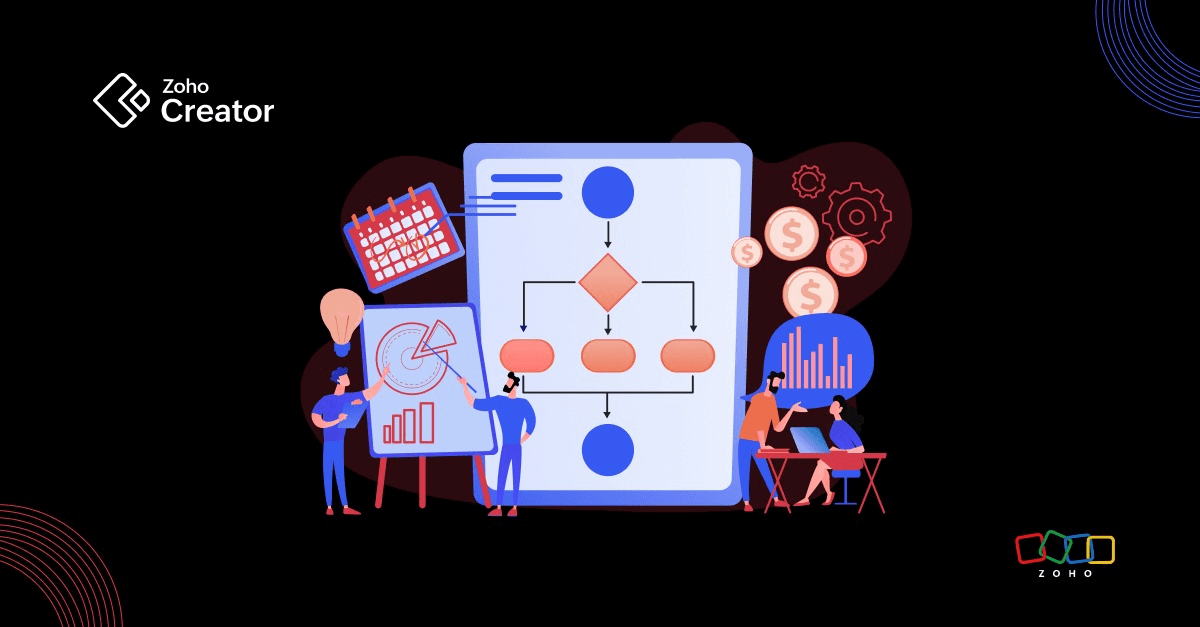- HOME
- Know Your Tech
- The top 11 digital transformation trends you need to know right now
The top 11 digital transformation trends you need to know right now
- Last Updated : November 17, 2025
- 178 Views
- 12 Min Read
Most businesses know they need digital transformation, but they struggle to identify genuinely emerging trends from the ones that have been around for years.
Highlights:
- Low-code platforms enhance development: Business teams can build sophisticated applications without extensive coding knowledge, accelerating transformation across organizations and reducing dependence on scarce technical resources.
Agentic AI makes autonomous decisions: AI systems now handle complex workflows independently, making decisions and taking actions without constant human oversight, moving beyond simple automation to strategic execution.
Platform engineering standardizes infrastructure: Internal developer platforms provide self-service capabilities that let teams deploy applications faster while maintaining consistent security and reliability standards across the organization.
Edge computing processes data locally: Businesses analyze information at the source rather than sending everything to centralized servers, enabling real-time responses and reducing bandwidth costs significantly.
Big data analytics drives predictive decisions: Organizations combine multiple data sources to identify patterns, forecast trends, and make proactive business decisions based on real-time insights rather than historical reports.
According to a recent study from Deloitte, technology budgets are projected to grow from 8% of revenue in 2024 to 14% in 2025, potentially reaching 32% of revenue by 2028 if current growth patterns continue. With this level of investment at stake, knowing which trends offer real competitive advantages becomes even more critical for business success.
In this blog post, we’ll explore the top 11 digital transformation trends that are changing how businesses operate in 2026 and beyond. Find out what makes each trend relevant, how it applies to real business scenarios with examples, and how you can use them for your needs. Let’s get started.
11 digital transformation trends shaping business in 2026
 Digital transformation fundamentally rethinks how your business operates by using emerging technologies to create new value for customers and employees.
Digital transformation fundamentally rethinks how your business operates by using emerging technologies to create new value for customers and employees.
With the latest technologies, the focus has shifted from simply digitizing manual processes to building intelligent, adaptive systems that can respond to change in real time.
Let’s take a detailed look at each of the top digital transformation trends and see how they’re impacting various business processes.
1. Low-code and no-code platforms
Low-code and no-code platforms have evolved from simple form builders to sophisticated development environments that can handle complex business applications. Modern platforms support advanced workflows, integrations with multiple systems, AI capabilities, and mobile deployment without requiring extensive programming.
This maturity means businesses can build applications that previously required full development teams. An operations manager can create a supply chain tracking system that integrates with ERP data, sends automated alerts based on conditions, and provides real-time dashboards for executives.
The platforms increasingly include AI-powered development assistants that suggest logic, generate code snippets, and help users build applications through conversational interfaces. This lowers the barrier even further, making application development accessible to people who understand business processes but lack technical training.
For instance, Zoho Creator’s AI capabilities help you build applications by describing what you need in plain language. The platform handles the technical implementation while you focus on business logic and user experience.
2. Agentic AI systems at work
Agentic AI represents a major shift from traditional AI that requires human oversight for every decision. These systems can set goals, plan sequences of actions, and execute tasks autonomously across multiple steps.
Unlike traditional AI approaches that focus on single tasks like image recognition or chatbot responses, agentic AI handles complex workflows. It can book travel arrangements by comparing options across multiple sites, negotiating prices, and managing changes based on your preferences. It makes decisions using reasoning capabilities rather than following rigid rules.
For instance, an agentic AI system in customer service can identify a billing issue, check the customer's history, determine the best resolution path, process a refund if appropriate, and follow up to ensure satisfaction. All of this happens without a human agent reviewing each step.
The shift to agentic AI changes how businesses think about automation. You're not just automating repetitive tasks anymore. You're delegating entire processes to systems that can adapt to unexpected situations.
3. Platform engineering
Platform engineering creates internal developer platforms that provide self-service capabilities for building, deploying, and managing applications. Instead of each team figuring out infrastructure, security, and deployment separately, platform teams build standardized tools and workflows that everyone uses.
The approach treats the development platform itself as a product, with dedicated teams gathering requirements from internal users and continuously improving the experience. This reduces the cognitive load on developers and ensures consistent practices across the organization.
For example, a platform team can create templates and automation that let product teams deploy new applications with proper security configurations, monitoring, and backup procedures already in place. Developers focus on building features rather than configuring infrastructure.
This trend reflects a shift from expecting every developer to be an expert in operations and infrastructure to letting specialists create great tools that others can use easily. It accelerates development while maintaining high standards for reliability and security.
4. Cloud and edge computing convergence
Edge computing processes data closer to where it's generated rather than sending everything to centralized cloud servers. This reduces latency, saves bandwidth, and enables real-time responses that cloud-only architectures can't provide.
Businesses can use edge computing for applications that need immediate processing. A retail store can analyze customer movements and adjust displays in real time without sending video feeds to distant data centers. A factory can detect equipment problems and stop production lines within milliseconds.
The convergence with cloud computing allows businesses to use both strategically. Edge devices handle time-sensitive processing and send summaries or important events to the cloud for long-term storage and deeper analysis. This hybrid approach balances speed with comprehensive data management.
For instance, a logistics company can track vehicle locations and conditions using edge devices that make immediate routing decisions, while sending trip data to cloud systems for optimization and reporting. The combination provides both real-time operations and strategic insights.
5. Spatial computing transforms interactions
Spatial computing merges physical and digital environments so you can interact with digital content as if it exists in the real world. This goes beyond virtual reality headsets to include augmented reality glasses, gesture recognition, and voice interfaces that understand spatial context.
Using spatial computing is especially useful for training scenarios that would be too expensive or dangerous in real life. For instance, a technician can practice repairing complex machinery while wearing AR glasses that overlay instructions and highlight components. The system tracks hand movements and provides real-time feedback.
Architecture and design firms can also create spaces where clients walk through buildings before construction starts. They can make changes by pointing and speaking, seeing updates instantly in the 3D space around them. This replaces endless revision cycles with immediate visualization.
Technology is reaching a point where the hardware is comfortable enough for extended use and the software is sophisticated enough to feel natural. You'll see more businesses adopting spatial computing for collaboration, training, and customer experiences in the coming years.
6. Big data analytics powers decisions
Big data analytics combines information from multiple sources to identify patterns, forecast trends, and support data-driven decisions. Modern analytics tools process structured and unstructured data in real time, providing insights that weren't possible with traditional business intelligence.
Organizations analyze customer behavior across channels, predict maintenance needs based on sensor data, and optimize operations by identifying inefficiencies. The key difference from earlier analytics is the speed and scale at which businesses can process information.
For example, an e-commerce company can analyze millions of transactions to detect fraud patterns, personalize product recommendations, and adjust pricing dynamically based on demand. All of this happens in real time rather than through overnight batch processing.
The accessibility of advanced analytics has improved dramatically. Cloud-based tools and AI-powered analysis mean you don't need data science teams to gain valuable insights from your fundamental business data.
7. Composable enterprise and modular architecture
Composable architecture breaks systems into modular components that can be reassembled quickly when business needs change. Instead of building one large application that's difficult to modify, you create smaller pieces that connect through standard interfaces.
This approach lets businesses respond to market changes much faster. For instance, if you want to change how you calculate shipping costs, you replace just the shipping component. The modules typically use APIs to communicate, so you can mix components from different vendors or different generations of technology.
You can use a modern, AI-powered recommendation engine alongside a legacy inventory system, connecting them through APIs without rebuilding either one.
For instance, a business using Zoho Creator can build applications with modular forms, workflows, and integrations that can be reconfigured as processes evolve. The AI-powered, low-code approach makes it easy for business users to make these changes without waiting for IT resources.
8. Supply chain digitalization and visibility
Supply chain digitalization provides real-time visibility into every step of the process from raw materials to final delivery. Digital tools track inventory levels, monitor shipment status, and predict potential disruptions before they impact operations.
This visibility helps businesses respond quickly to changes. If a supplier faces delays, the system can automatically identify alternative sources and adjust production schedules. If demand spikes unexpectedly, it can trigger expedited shipping for critical components.
The integration of IoT sensors, GPS tracking, and collaborative platforms ensures that everyone in the supply chain has access to accurate information. Suppliers, manufacturers, logistics providers, and retailers all see the same real-time data, reducing miscommunication and improving coordination.
For example, a manufacturer can track raw materials from suppliers, monitor work-in-progress on the factory floor, and follow finished products through distribution. When issues occur, they know exactly where the problem is and can take corrective action immediately.
9. Sustainable technology practices
Sustainable technology in 2026 will focus on reducing environmental impact through smarter system design. Businesses optimize code to use less processing power, choose efficient algorithms, and design applications that minimize data transfer.
This includes practices like designing databases to store only necessary data, compressing information intelligently, and scheduling non-urgent processing for times when renewable energy is most available. This helps build efficiency into every layer of the technology stack.
For instance, a company can redesign its mobile app to cache more information locally, reducing the number of server requests and the associated energy consumption. They can also choose edge computing for certain tasks to avoid sending data back and forth to centralized data centers.
Organizations can use digital tools to track the environmental impact of their technology choices, making sustainability metrics as visible as performance and cost metrics. This helps teams make informed decisions about whether certain features justify their environmental cost.
10. Real-time digital simulations
Digital simulations create virtual models of physical systems, processes, or environments that you can use for testing, training, and optimization. These simulations run in real time, incorporating live data to mirror actual conditions accurately.
Businesses can use simulations to test changes before implementing them in the real world. A logistics company can simulate different routing strategies to find the most efficient approach. A manufacturer can test new production layouts without stopping operations or moving equipment.
The simulations become more valuable as they incorporate more real-time data from IoT sensors, business systems, and external sources. They can predict how systems will behave under different conditions and help you make better decisions.
For example, a warehouse can run simulations that show how changing the location of popular items affects picking efficiency. They can test multiple layouts virtually and implement only the best option, avoiding costly trial and error.
11. Hyper-personalized customer experiences
Hyper-personalization uses AI and real-time data to create unique experiences for each customer based on their behavior, preferences, and context. This goes beyond basic segmentation to treat every customer as an individual with specific needs.
The technology analyzes vast amounts of data to understand each customer's preferences and delivers relevant content, recommendations, and offers at the right moment. It adapts continuously as customer behavior changes.
For instance, an online retailer can show different homepage layouts, product recommendations, and pricing strategies to each visitor based on their browsing history, purchase patterns, and current session behavior. So, with this technology in place, a customer researching camping gear sees outdoor equipment highlighted, while someone shopping for business attire sees professional clothing featured.
The key to effective hyper-personalization is balancing relevance with privacy. Customers appreciate personalized experiences when they feel in control of their data and understand how businesses use that data to customize interactions.
Why do these trends matter for your business?

Knowing which digital transformation trends offer real value helps you invest resources strategically rather than chasing every new technology that appears.
The returns on these investments can be substantial when implemented thoughtfully. In fact, according to a survey, 56% of executives in the United States report that returns on their digital transformation initiatives have surpassed their initial expectations.
Here's what makes the digital transformation trends particularly valuable:
Accessibility has improved dramatically: Cloud services, AI-powered low-code platforms, and API-based architectures mean you don't need massive IT budgets to implement sophisticated solutions that were once available only to large enterprises.
Speed creates competitive advantage: The businesses that implement these trends quickly gain advantages that compound over time, while waiting until trends become mainstream means you're always catching up to competitors.
Integration beats replacement: Modern approaches let you build on existing systems rather than replacing everything, making transformation more affordable and reducing the risk of disrupting working processes.
Human augmentation drives value: These trends focus on enhancing what people do well rather than just cutting costs through automation, helping your team work smarter and create better customer experiences.
Adaptability becomes essential: Markets change faster than ever, and these trends share a focus on building systems that can evolve quickly rather than locking you into rigid structures.
The businesses that will keep growing will be those that adopt these technologies to enhance capabilities rather than trying to replace human judgment entirely. Start with trends that address your specific challenges and expand based on results.
Build your digital transformation with Zoho Creator
Digital transformation sounds complex, but you don't need massive IT teams or years of development time to get started. The trends become easy to implement when you have the right tool.
Zoho Creator is an AI-powered low-code application development platform that helps you build custom applications aligned with these emerging trends. Whether you need to automate workflows, integrate multiple systems, or build mobile apps that connect your field teams, Zoho Creator gives you the flexibility to move fast without getting locked into rigid software.
Here's how Zoho Creator supports your digital transformation:
AI-powered app building: Use conversational AI to describe what you need and let Zoho Creator help you build the application structure, saving time and reducing complexity for users at any skill level.
Integrate with 1000+ applications: Connect to existing systems and create custom integrations using APIs, bringing together data from legacy platforms, modern cloud services, and everything in between.
Deploy across all devices: Applications you build work natively on the web, iOS, and Android without separate development efforts, supporting mobile workforces and distributed teams seamlessly.
Legacy system modernization: Connect and extend your existing legacy systems with modern applications instead of replacing them entirely, protecting your technology investments while adding new capabilities.
Empower business users: Non-technical team members can build and modify applications without waiting for IT resources, accelerating your transformation and enabling rapid experimentation with new approaches.
Zoho Creator handles the technical complexity so you can focus on solving business problems. You're not limited to predefined templates or limited by what the software vendor imagined. Instead, you have the flexibility to implement the specific digital transformation trends that matter most for your business.
Sign up for free today and start building applications that position you for 2026 and beyond.
FAQ
1. Which digital transformation trend should businesses prioritize first?
Prioritize trends that directly address your biggest operational challenges or customer pain points. If you struggle with slow application development, start with low-code platforms. If you need better decision-making, explore big data analytics. The right starting point depends on where you'll see the fastest return on effort.
2. How do composable architectures differ from traditional enterprise software?
Traditional enterprise software typically comprises large, monolithic applications that are difficult to modify or replace. Composable architectures use modular components connected through APIs, letting you swap out individual pieces without disrupting the whole system, making it easier to adapt as business needs change.
3. How long does it typically take to see results from digital transformation initiatives?
Results vary based on scope, but using modern tools, you can see initial value within weeks for specific process improvements. Start with focused projects that solve clear problems rather than company-wide transformations, validate the approach, then expand. Quick wins build momentum and justify larger investments.
4. Can businesses integrate emerging trends with their existing legacy systems?
Yes, modern integration approaches using APIs and middleware let you connect legacy systems with new technologies without replacing everything. You can build new capabilities on top of existing infrastructure, gradually modernizing while protecting investments in systems that still provide value.
5. How do you measure the success of digital transformation efforts?
Measure specific business outcomes tied to your goals rather than just technology adoption metrics. Track improvements in areas like time to complete processes, customer satisfaction scores, revenue from new capabilities, or cost reductions from automation, depending on what you're trying to achieve with transformation.
 Ashwin Raj S N
Ashwin Raj S NAshwin is a Growth Marketer for Zoho, with a passion for learning new things. In his spare time, he enjoys spending time with his family and friends, watching anime, and travelling.



